| "Music
is a moral law. It gives inspiration to the entire
world, wings to the soul and raises the thoughts of
man up to the heavens. Music is the basis of order.
It is the embodiment of eternal beauty and glory."
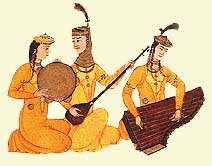 These words by the great Greek philosopher
Plato would find resonance in the soul of any Azerbaijani,
be he philosopher or just ordinary worker. If one
attempts to define the most characteristic feature
of Azerbaijanis, it would doubtless be their love
of music. Harmonic music lives in the very nature
of this land, in its soil, trees and rocks. Classic
Azerbaijani poetry is filled with lines about music
and the supreme spiritual enjoyment that it gives.
These words by the great Greek philosopher
Plato would find resonance in the soul of any Azerbaijani,
be he philosopher or just ordinary worker. If one
attempts to define the most characteristic feature
of Azerbaijanis, it would doubtless be their love
of music. Harmonic music lives in the very nature
of this land, in its soil, trees and rocks. Classic
Azerbaijani poetry is filled with lines about music
and the supreme spiritual enjoyment that it gives.
For example, the beauty of Azerbaijani songs was glorified
by the great poet of this land, Nizami Ganjavi:
Dear singer, take your saz in your arms,
Play sweet music for us,
Don't limit your range,
Our melodies are broad and rich.
Azerbaijani melodies have been adopted and sung by
people from all of the neighboring countries: Georgians,
Armenians, Turks, Dagestanis, Uzbeks and Turkmens.
This music has been imprinted in the musical memory
of these peoples and become accepted as their common
heritage. A number of written materials and sources
from the 19th century testify to the dominant role
of Azerbaijani musical culture in the Caucasus and
Central Asia. One can still find dozens of Azerbaijani
tunes widespread in this area, both national folk
tunes and those that were written by specific Azerbaijani
composers.
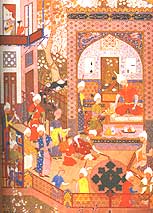 Azerbaijanis' love for music is closely
connected with their unique talent in this art form.
At the beginning of the 20th century, composer Uzeyir
Hajibeyov, the genius of Azerbaijani music, recognized
for writing the first opera of the Caucasus and the
Muslim East and acknowledged as the greatest figure
in the musical world of this region, wrote: "Without
the slightest exaggeration, it is possible to say
that among the Caucasian peoples, the most talented
in music are the Azerbaijani Turks." (1923).
Azerbaijanis' love for music is closely
connected with their unique talent in this art form.
At the beginning of the 20th century, composer Uzeyir
Hajibeyov, the genius of Azerbaijani music, recognized
for writing the first opera of the Caucasus and the
Muslim East and acknowledged as the greatest figure
in the musical world of this region, wrote: "Without
the slightest exaggeration, it is possible to say
that among the Caucasian peoples, the most talented
in music are the Azerbaijani Turks." (1923).
The rich musical heritage created since ancient times
is unchallengeable proof of a genetic talent that
is inherent in every generation of the Azerbaijani
nation. Our national musical instruments, designed
for the emotional color, rhythm, tempo and artistic
features of Azerbaijani folk music, have passed a
long path of historic development and carried many
characteristic features of Azerbaijani traditional
music up until the present. Now they are part of Azerbaijan's
musical culture, linking its past and present. Traditional
music and musical instruments express the major features
of Azerbaijani national musical thinking and the nature
of Azerbaijani creativity.
At the same time, we must regretfully admit that a
great deal of our national musical heritage has been
lost. This especially relates to the rich collection
of instruments used by Azerbaijanis during various
periods of our cultural history.
Numerous string, wind and percussion instruments were
created long before our era and improved throughout
history to become the basis of Azerbaijan's national
musical treasury. For centuries, they were used for
the cultural development and creative activity of
the people, decorating their lives, customs and traditions.
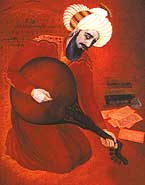 The 28 national musical instruments
presented in this album are the only ones that remain
of Azerbaijan's traditional musical culture. Ten of
them were reintroduced to musical life these past
few years as a result of my own research and reconstruction
efforts.
The 28 national musical instruments
presented in this album are the only ones that remain
of Azerbaijan's traditional musical culture. Ten of
them were reintroduced to musical life these past
few years as a result of my own research and reconstruction
efforts.
One of the most distinguished aspects of this research
has been the creation of an ensemble of musicians
who perform these ancient musical instruments. This
Ensemble was created in 1988 as part of the State
Museum of Azerbaijani Musical Culture. According to
a Presidential Decree, the Ensemble was awarded the
status of State Ensemble. The Ensemble consists of
1 3 musicians. Nine of these musicians play instruments
that had been forgotten-the chagane, choghur, barbat,
tanbur, santur, rud, chang, rubab and gopuz. The other
three play the canun (ganun), zarb and ney. The singer
accompanies himself or herself by playing the gaval
or daf.
The members of the Ensemble constantly work to improve
and expand the performing properties and sound and
technical capabilities of the ancient instruments.
The popularity that the Ensemble enjoys both inside
and outside of the country shows once again the great
interest in our cultural heritage.
Study and Recovery
of Musical Instruments
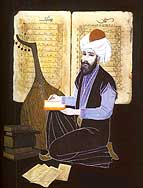 Asa
discipline of Azerbaijani musicology, instrumentology
comprises its own separate sphere. The descriptions
of ancient musical instruments provided by Azerbaijani
scholars, musicians, historians and ethnographers
are of great importance for the development of this
science. These include the valuable observations of
Uzeyir Hajibeyov, Afrasiyab Badalbeyli, Teymur Bunyadov,
Mirali Seyidov and Saadat Abdullayeva. Asa
discipline of Azerbaijani musicology, instrumentology
comprises its own separate sphere. The descriptions
of ancient musical instruments provided by Azerbaijani
scholars, musicians, historians and ethnographers
are of great importance for the development of this
science. These include the valuable observations of
Uzeyir Hajibeyov, Afrasiyab Badalbeyli, Teymur Bunyadov,
Mirali Seyidov and Saadat Abdullayeva.
Uzeyir Hajibeyov in particular contributed much to
the study of Azerbaijani folk instruments; he described
the characteristics and classifications of these musical
instruments in his works, including the ranges of
their modal scales and their prospects for further
development. (See his book, "The Principles of
Azerbaijani Folk Music" (Baku: Azeri 1 945, English
1 985).)
Published research about these musical instruments
has dealt with their structure, modal scales, technical
and artistic capabilities, the history of their evolution
and even the etymology of their names.
Despite the fact that these forgotten musical instruments
have been researched from time to time, their restoration
has never become a subject of study. In general, the
creation of musical instruments, their development,
and the etymology of names and places in the national
musical heritage have never been fully explored. This
book provides information about both contemporary
instruments and the musical instruments that were
widespread during the Middle Ages but later forgotten
due to various reasons.
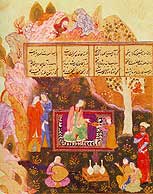 The
restoration of ancient musical instruments begins,
first of all, with the study of medieval written sources
and miniatures. The works of numerous researchers
and musicians, the notes of travelers, samples of
folk and classical poetry and miniatures refer to
the existence of a variety of string, wind and percussion
instruments. This certainly proves that there is a
rich heritage of musical instruments belonging to
the Azerbaijani nation. Presented below is a summary
of the sources that were used in researching and reconstructing
these ancient instruments. The
restoration of ancient musical instruments begins,
first of all, with the study of medieval written sources
and miniatures. The works of numerous researchers
and musicians, the notes of travelers, samples of
folk and classical poetry and miniatures refer to
the existence of a variety of string, wind and percussion
instruments. This certainly proves that there is a
rich heritage of musical instruments belonging to
the Azerbaijani nation. Presented below is a summary
of the sources that were used in researching and reconstructing
these ancient instruments.
The most ancient artifacts related to Azerbaijani
musical culture have been found in historical monuments
and amongst the material culture that has been found
in archeological excavations. A number of objects
that have found during archeological digs are related
to musical instruments. For instance, during the construction
of the Mingachevir Water Basin, three musical instruments-tutak,
zurna and ney-were discovered; these were made of
clay or bone.
Azerbaijani classical poetry and oral history is also
a rich source of information. Almost all great Azerbaijani
poets and writers touched upon musical instruments
in their works. The poetry of Nizami and Fuzuli provides
an inexhaustible source for such research. These poets
described the instruments' timbre and appearance and
gave us very important information about the methods
of their creation and the manner in which they were
played.
Musical science also provides us with very important
information about the ancient instruments of Azerbaijan.
Treatises by medieval musicologists provide information
about the pitch and scale of these instruments, the
number of strings, the ranges and other data, giving
us an idea of their acoustic quality. The scientific
heritage of Azerbaijani musicologists like Safiaddin
Urmavi (13th century) and Abdulgadir Maraghayi (14th-15th
centuries) provides us with the most valuable and
extensive information for studying these instruments.
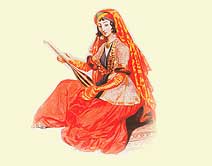 Without visual materials that illustrated
what these instruments looked like, we would not have
been able to restore them to any measure of authenticity
or credibility. Therefore, the sketches and drawings
of musical instruments that we find in decorative
and applied art, on ancient pottery, and in architecture
and monumental paintings of the pre-Moslem epoch,
are of enormous value.
Without visual materials that illustrated
what these instruments looked like, we would not have
been able to restore them to any measure of authenticity
or credibility. Therefore, the sketches and drawings
of musical instruments that we find in decorative
and applied art, on ancient pottery, and in architecture
and monumental paintings of the pre-Moslem epoch,
are of enormous value.
Another body of research relates to the memoirs, travel
notes and other literature from scientists, writers,
diplomats and other travelers who visited Azerbaijan
centuries ago. Information about musical instruments
used in Azerbaijan in the 17th, 1 8th and 19th centuries
can be found in the travel notes and memoirs of Adam
Oleari, Engelbert Kaempfer, Alexander Dumas, Evliya
Chelebi and others.
Drawings and paintings by the famous Russian painter
G. Gagarin, who visited Azerbaijan in the 19th century,
depict scenes of musical majlises (assemblies), musicians
and dancers belonging to the khanate of Shirvan.
The Research Laboratory for the Restoration and Improvement
of Ancient Musical Instruments opened at Baku Music
Academy in 1991. Researchers at this laboratory study
the history of musical instruments and explore questions
about their technology, including size, materials
and acoustics. Reconstruction is performed on the
basis of the information gathered.
Laboratory research of museum exhibits and archive
materials has produced valuable results as well. In
this sense, the work of the researchers of the laboratory
should specifically be noted. As a result of their
efforts, instruments that were broadly used in medieval
Azerbaijan and later forgotten-such as the chang,
barbat, chagane, choghur, santur, tanbur, rubab, gopuz
and ney-have been completely restored.
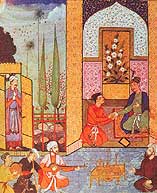 We have also been working to restore
existing instruments. For example, in order to strengthen
sonority, some structural changes are being introduced.
Another example is that the material used to make
strings has been changed and the sound diapason has
been widened. For example, the gut or silk that were
used in the santur have been replaced with nylon threads
or metallic wire. A clamp-like piece that presses
against the strings was added to the body of the santur
in order to keep the strings from vibrating.
We have also been working to restore
existing instruments. For example, in order to strengthen
sonority, some structural changes are being introduced.
Another example is that the material used to make
strings has been changed and the sound diapason has
been widened. For example, the gut or silk that were
used in the santur have been replaced with nylon threads
or metallic wire. A clamp-like piece that presses
against the strings was added to the body of the santur
in order to keep the strings from vibrating.
The instruments that we have managed to recover represent
only a small number of all the forgotten ancient instruments
that once existed. There is still an enormous amount
of research to be done. Ancient musical instruments
are the monuments of the history, culture and spirituality
of our nation. Restoring them and returning them to
life is a noble and worthy occupation.
Performinf Arts
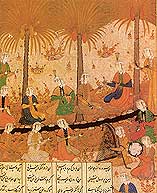 One of the most interesting pages in
Azerbaijan's musical history relates to the performances
of these ancient instruments. There is great historical
value in the performing arts that have absorbed the
rich traditions of Azerbaijani folk music. Early examples
of written literature, history, architecture and fine
art prove that the performing arts have been a favorite
aspect of musical activity throughout the ages.
One of the most interesting pages in
Azerbaijan's musical history relates to the performances
of these ancient instruments. There is great historical
value in the performing arts that have absorbed the
rich traditions of Azerbaijani folk music. Early examples
of written literature, history, architecture and fine
art prove that the performing arts have been a favorite
aspect of musical activity throughout the ages.
For example, "Kitabi Dada Gorgud" (The Book
of Dada Gorgud), our most famous ancient epic, indicates
that playing the gopuz was recognized as a holy and
noble occupation. Our classical poets presented delicate
and loving images of well-known ancient musicians
and offered a great deal of interesting data about
them.
When the song of Nikisa's chang fell silent,
Barbat's sitar raised its voice.
As the light-headed ashug touched the saz,
At once he began to sing the gazal in the Ushshag
.
Here, in the story of "Khosrov and Shirin",
the great poet Nizami Ganjavi describes a scene of
competition between two unsurpassed musicians of the
past, Nikisa and Barbat, both of them composers, singers
and performers. Nikisa and Barbat outshined the greatest
glory of their contemporaries in their ability to
play the chang and barbat.
We know from history that many outstanding persons,
poets, writers and scientists from Azerbaijan were
also master performers on various musical instruments.
Safiaddin Urmavi, a first-rate scientist-theorist
of Eastern music, is one of the most famous. He was
also known for his mastery of the instrument known
as the ud.
 Throughout history, performing arts
have developed and matured both artistically and technically.
Beginning in the second half of the 19th century,
musical gatherings ("majlises") were held
in Baku, Shamakhi and Karabakh, which helped to improve
both the singing and performing arts. Outstanding
performers such as Mirza Sadig Asadoghlu, Mashadi
Jamil Amirov, Bahram Mansurov, Ahmad Bakikhanov, Gurban
Pirimov, Mansur Mansurov and many others from the
19th-20th centuries grew up attending these musical
assemblies.
Throughout history, performing arts
have developed and matured both artistically and technically.
Beginning in the second half of the 19th century,
musical gatherings ("majlises") were held
in Baku, Shamakhi and Karabakh, which helped to improve
both the singing and performing arts. Outstanding
performers such as Mirza Sadig Asadoghlu, Mashadi
Jamil Amirov, Bahram Mansurov, Ahmad Bakikhanov, Gurban
Pirimov, Mansur Mansurov and many others from the
19th-20th centuries grew up attending these musical
assemblies.
During the second half of the 20th century, tar and
kamancha performances rose to an even higher level
of development. Performers such as Habib Bayramov,
Baba Salahov, Haji Mammadov, Habil Aliyev, Shafiga
Eyvazova, Aghasalim Abdullayev, Ramiz Guliyev, Mohlat
Muslimov, Fakhraddin Dadashov, Munis Sharifov and
many other instrumentalists raised the bar for performance
technique and expanded the capabilities of Azerbaijani
national musical instruments.
|